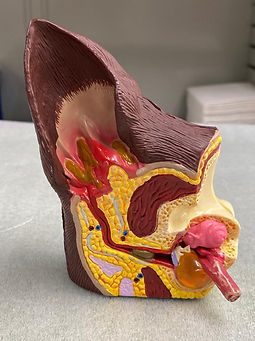The Anatomy of Animal Hearing system
.jpeg)
Grasping the intricacies of animal hearing and its anatomy is essential for diagnosing and treating hearing disorders. While the anatomy of animal hearing shares some similarities with human hearing, it varies significantly across different species. Animals have developed unique auditory structures and capabilities to adapt to their ecological niches and survival needs.
The Anatomy of the Animal Ear
Components & Functions
Anatomy of an animal’s ear is like human, with three main parts: the outer ear, middle ear, and inner ear. Each part plays a crucial role in the hearing process:
-
Outer Ear: Captures sound waves and funnels them into the ear canal.
-
Middle Ear: Contains the eardrum and three tiny bones (ossicles) that amplify sound vibrations.
-
Inner Ear: Converts sound vibrations into electrical signals that are sent to the brain.

Anatomy of Dog ear

Anatomy of Horse ear
The main components and their functions are:
-
The outer ear contains
-
Pinna: the external part of the ear that captures sound waves and directs them into the ear canal. Its shape and size vary greatly among species, influencing their hearing range and sensitivity.
-
Ear canal: A tube that leads sound waves from the pinna to ear drum. It has different forms (straight or curved), depending on the species.
-
-
The Middle ear contains:
-
Tympanic membrane (eardrum): A thin membrane that vibrates in response to sound waves and converts then to mechanical vibrations.
-
Ossicles (three tiny bones): A chain of three small bones that transmit and amplify sound vibrations from the eardrum to the inner ear.
-
Eustachian tube: A tube that connects the middle ear to the pharynx, equalizing pressure on both sides of eardrum.
-
-
The Inner ear contains:
-
Cochlea: A spiral-shaped, fluid-filled structure that converts mechanical vibrations to neural signals. It has hair cells within cochlea hat respond to different frequencies which detect a range of sounds.
-
Semicircular canals: Three fluid-filled tubes that help with balance and spatial orientation which are part of the vestibular system.
-
-
Auditory pathways contains:
-
Auditory nerve: It transmits neural signals from the cochlea to the brain.
-
Brain: it processes auditory information, allowing the animal to recognize and respond to sounds.
-
Animal's Unique Adaptations
-
Dogs have a highly sensitive hearing range, especially in higher frequencies, which helps them to detect distant or high-pitched sounds.
-
Horses possess excellent hearing abilities, particularly in higher frequencies, aiding in detecting predators and quick flight response.
-
Dolphins utilize echolocation, emitting clicks and interpreting the returning sound waves to navigate and hunt underwater.
.jpeg)



